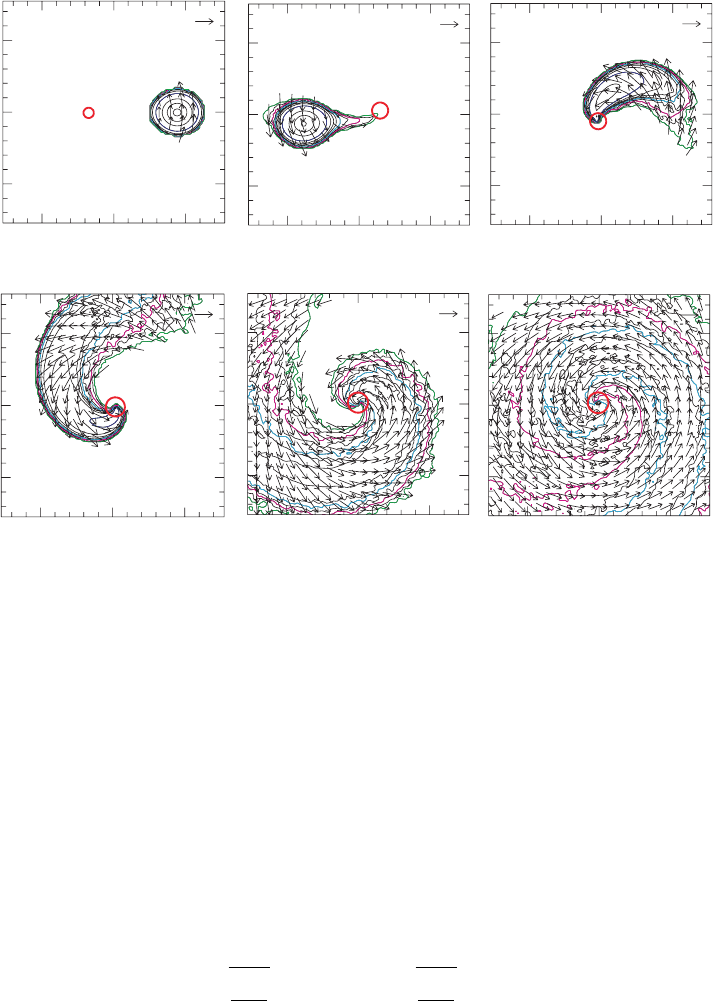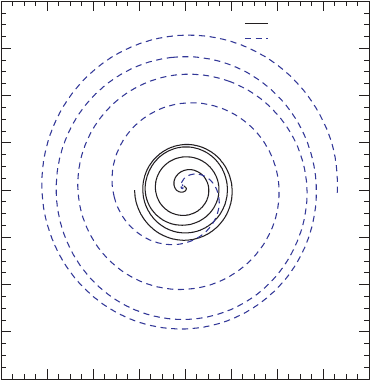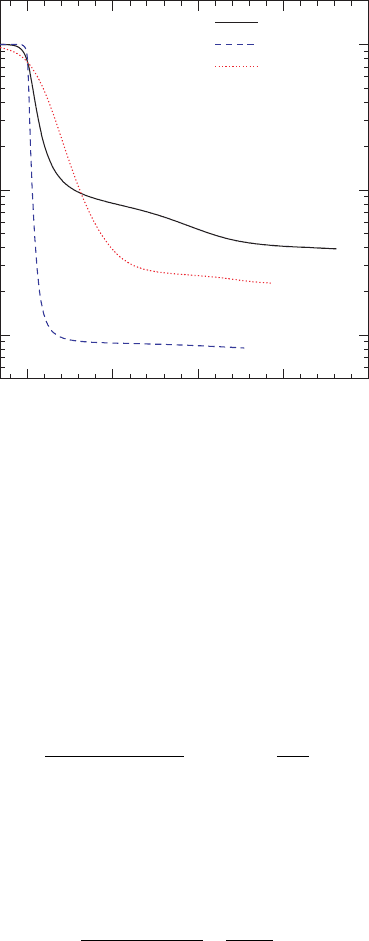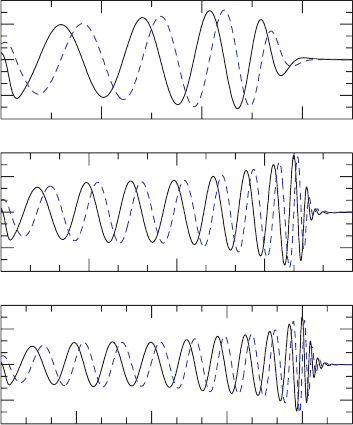Baumgarte T., Shapiro S. Numerical Relativity. Solving Einstein’s Equations on the Computer
Подождите немного. Документ загружается.


17.2 Dynamical simulations 581
0
0
0.3c
0.3c
0.3c
0.3c
0.3c
X / M X / MX / M
X / M X / MX / M
Y / MY / M
5
5
t = 0.00 M
t = 126 M
t = 151 M
t = 185 M
t = 60.4 M
t = 106 M
−5
05
−5
05
−5
−5
0
0
5
5
−5
05
−5
05
−5
−5
0.3c
Figure 17.6 Snapshots of rest-density contours and 3-velocity vectors at selected times during the binary
merger of a 1.3M
neutron star corotating about a 3.2M
nonspinning black hole. The total initial ADM mass of
the system is M = 4.5M
. Contours are drawn in the orbital plane at ρ
0
= 10
14
(blue), 10
12
(cyan), 10
11
(magenta), and 10
10
gcm
−3
(green). The maximum density at t = 0is≈ 7.2 × 10
14
gcm
−3
. The thick red circle
denotes the apparent horizon. [From Shibata and Ury
¯
u (2007).]
short-hard GRB, the merger and disruption of a neutron star with a low-mass black hole
might be the progenitor of such a source. A representative tidal disruption is illustrated in
Figure 17.6.
Gravitational waveforms for a typical merger are shown in Figure 17.7.Thewavesare
extracted from the metric near the outer boundaries of the grid, using the gauge-invariant
Moncrief formalism discussed in Chapter 9.4.1. In particular, Shibata and Ury
¯
u (2006,
2007) focus on the dominant even-parity, l = 2 mass quadrupole modes and define the
quantities
R
+
=
)
5
16π
R
22+
, R
×
=
)
5
16π
R
22−
, (17.29)
where R
lm±
are the even-parity functions defined in equations (9.117).
Exercise 17.5 Why do the functions R
21±
vanish for these simulations?

582 Chapter 17 Binary black hole–neutron stars
0
0.2
0.1
−0.1
0.1
−0.1
−0.2
−0.2
0.2
0
0
R× / M
R
+ / M
50 100 150 200
t
ret
/ M
Figure 17.7 Gravitational waveforms for the binary merger of a 1.3M
neutron star corotating about a 4.0M
black hole. The total initial ADM mass of the system is M = 5.3M
(see text). [From Shibata and Ury
¯
u (2007).]
The wave amplitude assumes its maximum for observers viewing along the binary axis,
perpendicular to the orbital plane, for which we may write
h ≡
h
2
+
+ h
2
×
=
R
2
+
+ R
2
×
r
≈ 1.0 × 10
−22
R
2
+
+ R
2
×
0.31 km
100 Mpc
D
,
(17.30)
where D is the distance of the observer to the source.
Exercise 17.6 Verify equation (17.30).
Hint: Use equations (9.115)and(9.116).
From Figure 17.7, which applies to a system with total mass M ≈ 5.3M
, this maximum
amplitude is h ≈ 5 × 10
−22
for a characteristic distance of D = 100 Mpc. Such a waveform
should be detectable by a gravitational wave laser interferometer like advanced LIGO. The
waveform exhibits the characteristic increase in amplitude and frequency during the late
inspiral phase, t
ret
≡ t − D
<
∼
120M. At the end of the inspiral the wavelength of the
radiation is ∼25M, appropriate for orbital motion near the ISCO. For 120
<
∼
t
ret
/M
<
∼
150,
black hole ringdown radiation is evident, with an expected quasinormal wavelength of
∼15M
f
BH
, where the final black hole mass M
f
BH
is comparable to the total initial mass of
the binary.
17.2 Dynamical simulations 583
Irrotational binaries
The merger of irrotational binaries (irrotational neutron stars orbiting nonspinning black
holes) has been treated by several investigators in full general relativity.
35
The emphasis has
been on low-mass cases (q
<
∼
5) for which the neutron star undergoes tidal disruption prior
to capture. In most of these investigations, the gravitational fields are evolved by the BSSN
scheme, and the matter is evolved by a HRSC algorithm on the same spacetime lattice.
By contrast, Duez et al. (2008) evolve Einstein’s equations by a first-order representation
of the generalized harmonic formulation using pseudo-spectral methods. The equations of
hydrodynamics are evolved on a separate grid using shock-capturing finite difference or
finite volume techniques. The consensus of all the studies is that a toroidal disk forms
around the black hole in most cases but that the typical disk masses are much lower than
the values quoted in the previous sections. In the following discussion we shall highlight
the calculations of Etienne et al. (2009), in part to facilitate a comparison in the next section
with spinning black holes, which they also treat. For irrotational binaries, Etienne et al.
(2009) find that, though indeed lower, the disk masses of 0.01–0.05M
that form around the
remnant black hole following neutron star disruption are still astrophysically significant.
The code developed by Etienne et al. (2009) is a refinement of the BSSN HRSC
relativistic MHD scheme of Duez et al. (2005b) discussed earlier in the book in several
other contexts.
36
Their most significant improvement consists of the implementation of
AMR
37
to track the evolution of the strong-field, inner regions at high resolution while
simultaneously allowing the grid to extend far out into the wave zone for more accurate
wave extraction and more reliable boundary conditions. Etienne et al. (2009) launched
a new suite of tests to check the AMR version of their code. These tests involved both
vacuum spacetimes and spacetimes with hydrodynamic matter sources and included shock-
tube tests and simulations of linear gravitational waves, single stationary and boosted
puncture black holes, puncture black hole binary mergers,
38
rapidly and differentially
rotating equilibrium stars, and relativistic Bondi accretion onto a Schwarzschild black hole.
Convergence tests performed in all cases confirmed the reliability of the AMR version.
The BSSN equations are integrated with fourth-order accurate, centered, finite-
differencing stencils, except on shift advection terms, where fourth-order accurate upwind
stencils are used. Outgoing wave boundary conditions are adopted for all BSSN fields.
Fourth-order Runge–Kutta time-stepping is managed by a MoL (Method of Lines) routine,
with a Courant–Friedrichs–Lewy factor set to 0.45.
39
Etienne et al. (2009) find that in the
presence of hydrodynamic matter, the evolution of the conformal variable φ rather than
35
See, e.g., Shibata and Taniguchi (2007); Etienne et al. (2008); Yamamoto et al. (2008); Duez et al. (2008); Etienne
et al. (2009).
36
See, e.g., Chapters 5.2.4, 14.2.3,and16.3.
37
The implementation uses the moving-box AMR infrastructure provided by the “Carpet” algorithm; see Schnetter et al.
(2004) for a description of the FMR version of the AMR algorithm and http://www.carpetcode.org for
publically available modules of the AMR version.
38
See Appendix I, where these simulations of binary black hole mergers are summarized, together with some of the
features of the vacuum sector of this AMR code.
39
See Chapter 6 for a discussion of these concepts.
584 Chapter 17 Binary black hole–neutron stars
χ = e
−4φ
or W = e
−2φ
yields a more stable evolution near the black hole puncture and
better rest-mass conservation.
40
The equations are evolved using standard puncture gauge
conditions: an advective “1+log” slicing condition for the lapse and a “Gamma-driver”
condition for the shift.
41
The HRSC scheme for the hydrodynamics is second-order accurate for laminar flow,
but first-order accurate when discontinuities like shocks arise. To stabilize the scheme in
vacuum regions, a tenuous atmosphere is maintained, with a density floor ρ
atm
set equal to
10
−10
times the initial maximum density on the grid.
Etienne et al. (2009) consider irrotational binaries with mass ratios q = 1, 3 and 5. For
initial data they use the quasiequilibrium models constructed using the conformal thin-
sandwich method in Taniguchi et al. (2008). All three cases are tracked from approximately
the same starting value of M,where is the orbital angular velocity and M is the total
ADM mass. The black hole interiors are excised in this method, but with suitable care these
regions can be filled with smooth, but otherwise arbitrary, constraint-violating “junk” initial
data that does not affect the black hole exterior when evolved.
42
The neutron stars obey
an n = 1 polytropic EOS initially and evolve accordingly to a = 2 adiabatic EOS. All
neutron stars in this study have the same nondimensional rest mass,
¯
M
0
= 0.15, which is
83% of the maximum rest mass of a nonrotating star built with the same polytropic EOS;
the compaction of the adopted neutron star is
C = 0.145 in isolation.
The q = 3 case (case A) represents a generic tidal disruption scenario. Evolution starts
from a binary coordinate separation of D
0
/M =8.81, corresponding to M = 0.0333.
The AMR grid used in this case has nine levels of refinement; there are two sets of nested
refinement boxes, one centered on the black hole and the other on the neutron star. The
maximum resolution (minimum spacing) is M/32.5 in the innermost box centered on the
black hole. Approximately 41 grid points cover the diameter of the (spherical) apparent
horizon initially and 85 grid points cover the (smallest) diameter of the neutron star. The
outer boundary of the grid is located at r/M = 197.
Figure 17.8 shows the inspiral trajectories of the black hole and neutron star while
Figure 17.9 shows snapshots of the density and velocity vectors at selected times during
the evolution for the q = 3 case. Note that the equilibrium shape of the neutron star is
hardly disturbed for the first two orbits (upper middle). The lower panels show how the
neutron star tail deforms into a quasistationary disk, as the bulk of the matter is accreted
onto the black hole. A time history of the rest-mass consumption by the black hole is plotted
in Figure 17.10 for this case, as well as for the irrotational q = 1 (case E) and 5 (case D)
mergers. Astrophysically, we expect that the formation of a binary black hole–neutron star
will typically occur with q > 1.
Figure 17.10 suggests that for q = 3andq = 1 there are two distinct phases during
which matter falls into the black hole following tidal disruption of the neutron star: an
40
In contrast to evolution on a fixed grid using a conservative HRSC scheme, rest-mass conservation is not guaranteed
on an AMR grid, where spatial and temporal prelongation (interpolation) is performed at the grid boundaries.
41
See equations (4.51)and (4.83), implementing the “shifting shift” version in the later case.
42
Etienne et al. (2007); see also Brown et al. (2007).

17.2 Dynamical simulations 585
0
8
BH
NS
6
4
2
0
−2
−4
−6
−8
−8 −6 −4 −2
2468
X / M
Y / M
Figure 17.8 Trajectories of the black hole and neutron star coordinate centroids for the merger of an irrotational
binary with mass ratio q = 3 (case A). The black hole (BH) centroid corresponds to the centroid of the apparent
horizon, and the neutron star (NS) centroid is computed via the integral
˜
X
i
c
≡ (
V
x
i
ρ
∗
d
3
x)/(
V
ρ
∗
d
3
x), where
V is the total simulation volume. [From Etienne et al. (2009).]
initial plunge phase and a secondary accretion phase. The plunge phase occurs early in
the merger as part of the disrupted star streams onto the black hole and the remainder
deforms into a tidal tail. The plunge phase ends after 70–90% of the matter falls into
the BH, resulting in a sudden drop in the slope of the exterior M
0
vs. time plot in the
figure. The debris in the tail, having larger specific angular momentum, spreads out and
forms a disk. Material with lower specific angular momentum in the disk accretes onto the
BH. Since there is neither viscosity nor magnetic fields in this simulation, the accretion
should eventually cease as the evolution continues. However, in realistic astrophysical
environments, viscosity and magnetic fields frozen into the initial gas will drive further
accretion on secular time scales.
43
For the q = 5 case plotted in Figure 17.10 the neutron star essentially plunges into hole,
leaving < 1% of its rest mass outside the horizen at the end of the simulation. This result
is not surprising since, at the ISCO, the tidal effect of the black hole is smaller for larger q,
resulting in tidal disruption occurring closer to the ISCO. Moreover, for a given neutron star,
the horizon size of the black hole is larger for larger q, making it easier to capture neutron
star matter during the plunge. More surprising is the result that the disk mass in the q = 1
case (M
disk
/M
0
≈ 2.3%) is less than the disk mass in the q = 3 case (M
disk
/M
0
≈ 3.9%).
This result is presumably due to the complicated interaction of the disrupted matter in the
43
Recall the examples of viscous and MHD disk accretion onto black holes discussed in Chapter 14.2.4 and 14.2.5.

586 Chapter 17 Binary black hole–neutron stars
10
t = 0.0M
t = 524.0M t = 550.6M t = 869.2M
Case A
Case A
Case A
0.5c
0.5c
0.5c
Case A
0.5c
5
0
−5
−10
−10
−5
0510
X / M X / M X / M
X / M X / M X / M
Y / M
Y / M
Y / M
10
5
0
−5
−10
−10
−5
0510
Y / M
10
5
0
−5
−10
−10
−5
0510
Y / M
10
5
0
−5
−10
−10
−5
0510
Y / M
10
5
0
−5
−10
−10
−5
0510
10
t = 324.0M
t = 460.3M
Case A
0.5c
Case A
0.5c
5
0
−5
−10
−10
−5
0510
10
5
0
−5
−10
−10
−5
0510
Figure 17.9 Snapshots of rest-density contours and 3-velocity vectors at selected times during the merger of the
irrotational black hole-neutron star binary with mass ratio q = 3 shown in Figure 17.8 (case A). The contours
represent the density in the orbital plane, plotted according to ρ
0
= ρ
0,max
10
−0.38 j−0.04
, ( j = 0, 1,...,12), with
darker gray scaling for higher density. The maximum initial neutron star density is Kρ
0,max
= 0.126, where K is
the initial polytropic gas constant, or ρ
0,max
= 9 × 10
14
gcm
−3
(1.4M
/M
0
)
2
. Arrows represent the velocity field
in the orbital plane. The apparent horizon interior is marked by a filled black circle. In cgs units, the initial ADM
mass for this case is M = 2.5 × 10
−5
(M
0
/1.4M
)s= 7.6(M
0
/1.4M
) km. [From Etienne et al. (2009).]
merging process. A low-density, hot spiral region of disrupted matter winds around the
black hole and smashes into the tidal tail of the disrupted star, causing significant shock
heating. As shown in exercise 17.7 the degree of shock heating can be considerable in a
supersonic, low-density stream. Some of the heated matter transfers angular momentum to
the other part of the tail and then falls into the black hole. The remaining matter in the tail
deforms into an inhomogeneous disk before settling into a quasistationary state in which
a high density, relatively low temperature torus of matter surrounds the black hole.
Exercise 17.7 Shock heating can be measured by the degree to which the polytropic
gas constant K ≡ P/ρ
0
increases in a gas that passes through a shock front. Recall
that this quantity remains constant for adiabatic flow in the absence of shocks.
Assume Newtonian hydrodynamics in doing this exercise.

17.2 Dynamical simulations 587
0
0.01
0.1
1
Case A
Case D
Case E
100 200
3:1 = M
BH
:M
NS
1:1
5:1
300 400
(t − t
25
) / M
M
0
Fraction Outside AH
Figure 17.10 Rest-mass fraction outside the black hole as a function of time for irrotational binaries with
different mass ratios. Here, the time coordinate is shifted by t
25
, the time at which 25% of the neutron star
rest-mass has fallen into the apparent horizon. [From Etienne et al. (2009).]
(a) Assume that matter evolves adiabatically with the same adiabatic constant >1
both before and after entering a planar shock front. Let the upstream Mach number
in a fluid entering a shock be defined by
M ≡ v
1
/c
1
,wherev
1
is the upstream flow
as viewed in the frame of the shock front and c
1
is the upstream sound speed. Use
the fact that the flow always enters a shock front supersonically (i.e.,
M > 1) to
show that the downstream-to-upstream ratio of the gas constants is given by
K
2
/K
1
=
2
M
2
− ( − 1)
( + 1)
+1
− 1 +
2
M
2
. (17.31)
Prove that this ratio is always larger than unity.
(b) Evaluate
M in terms of v
1
and ρ
1
and argue that for a given upstream velocity,
M is larger for a lower density fluid.
(c) Assume highly supersonic flow
M 1andshowthat
K
2
/K
1
≈
2v
2
1
( + 1)K
1
ρ
−1
1
− 1
+ 1
. (17.32)
Equation (17.32) shows that when the density ρ
1
of the upstream matter is low, the
degree of shock heating downstream can be substantial, i.e., K
2
/K
1
1.
Etienne et al. (2009) find that the disk is smallest and most dense for the q = 1
binary. Specifying the length scale in km via the relation M = 1.9(q + 1)(M
0
/1.4M
)km,
and setting the neutron star rest mass M
0
equal to 1.4M
, they obtain a characteristic

588 Chapter 17 Binary black hole–neutron stars
radius of r
disk
≈ 20 km and a maximum density of ρ
0,max
≈ 6 × 10
12
gcm
−3
for this
disk. The corresponding values for the disk in the q = 3 case are r
disk
≈ 50 km and
ρ
0,max
≈ 4 × 10
11
gcm
−3
. In all cases the disk forms a hot, thick torus whose height is
about 15–20% of the characteristic radius and whose density plummets at the black hole
ISCO. The low-density regions are hottest, due to shock heating (see exercise 17.7). How-
ever, the gas constant K ≡ P/ρ
0
increases by more than a factor of 6 everywhere in the
q = 1 disk and by more than 85 everywhere in the q = 3disk.
Etienne et al. (2009) determine the thermal temperature T in the gas from the specific
energy density , which can determined from the evolved hydrodynamic variables. For a
polytropic equation of state, the “cold” contribution
cold
is defined as
cold
=−
P
cold
d(1/ρ
0
) =
K
cold
− 1
ρ
−1
0
, (17.33)
where P
cold
≡ K
cold
ρ
0
governs the initial (cold) neutron star. Now define the thermal
contribution to the specific energy density generated by shock heating as
th
= −
cold
and compute the thermal contribution according to
th
= −
cold
=
1
− 1
P
ρ
0
−
K
cold
− 1
ρ
−1
0
= (K /K
cold
− 1)
cold
. (17.34)
To estimate T , Etienne et al. (2009) model
th
according to
th
=
3kT
2m
n
+ f
s
aT
4
ρ
0
, (17.35)
where m
n
is the mass of a nucleon, k is the Boltzmann constant, and a is the radiation
constant. The first term represents the approximate thermal energy of the nucleons, and the
second term accounts for the thermal energy due to radiation and (thermal) relativistic parti-
cles. The factor f
s
reflects the number of species of ultrarelativistic particles that contribute
to thermal energy. When T 2m
e
/k ∼ 10
10
K, where m
e
is the mass of electron, thermal
energy is dominated by photons and f
s
= 1. When T 2m
e
/k, electrons and positrons
become ultrarelativistic and also contribute to the energy, and f
s
= 1 + 2 × (7/8) = 11/4.
At sufficiently high temperatures and densities (T
>
∼
10
11
K, ρ
0
>
∼
10
12
gcm
−3
), thermal
neutrinos are copiously generated and become trapped, so, taking into account three flavors
of neutrinos and antineutrinos, f
s
= 11/4 + 6 × (7/8) = 8.
Using equation (17.35), the characteristic temperature is T ∼ 5 × 10
10
K(or∼4MeV)
in the disk formed following the q = 3 binary merger, with comparable values for the
other disks. Numerical models of rotating black holes with ambient disks with similar
temperatures and densities suggest that such systems can produce a total gamma-ray energy
E ∼ 10
47
–10
50
erg from neutrino-antineutrino annihilation.
44
This result is promising for
generating a short-hard GRB from a merging black hole–neutron star binary.
44
Setiawan et al. (2006).

17.2 Dynamical simulations 589
0
0.15
0
0 100
150
150
Case E
Case A
Case D
200 300
300
300
(t − r
ex
) /M
(r
ex
/ M)h
22
(r
ex
/M)h
22
(r
ex
/M)h
22
450
450
600
600
0
−0.15
−0.15
−0.15
0.15
0.15
0
0
Figure 17.11 Gravitational wave signal for irrotational binaries with mass ratios (top to bottom) q = 1, 3, and
5. The black solid (blue dash) line denotes the (2,2) mode of h
+
(h
×
) extracted at r
ex
= 43.4M.[FromEtienne
et al. (2009).]
Gravitational waveforms are computed for the three cases described above and the results
are compared in Figure 17.11. Waveforms extracted at different radii are found to overlap
well provided the extraction radius is sufficiently large: r
ex
>
∼
40M. With approximately the
same initial M, we observe more wave cycles are emitted as the mass ratio q is decreased.
The amplitudes are attenuated at frequencies roughly equal to double the orbital frequency
at which tidal disruption begins.
Exercise 17.8 The gravitational waveforms h
+
and h
×
can be decomposed into
s =−2 spin-weighted spherical harmonics
−2
Y
lm
according to
h
+
− ih
×
=
l,m
(h
lm
+
− ih
lm
×
)
−2
Y
lm
, (17.36)
where h
lm
+
and h
lm
×
are real functions. Each (l, m) mode is a function of radius and
time only.
(a) Use the results of Chapter 9.4 to express h
lm
+
and h
lm
×
in terms of gauge-invariant
Moncrief functions.
(b) Use the results of Chapter 9.4 to express h
lm
+
and h
lm
×
in terms of the Weyl scalar
ψ
4
.
One significant measure of the accuracy of the simulations is provided by the degree to
which energy and angular momentum are conserved. Etienne et al. (2009) calculate the

590 Chapter 17 Binary black hole–neutron stars
diagnostic quantities
δE ≡ M − M
f
− E
GW
, (17.37)
δ J ≡ J − J
f
− J
GW
, (17.38)
where M and J are the ADM mass and angular momentum of the initial binary, M
f
and
J
f
are the ADM mass and angular momentum of the final system, and E
GW
and J
GW
are the energy and angular momentum carried off by gravitational waves. Assuming that
no matter or other form of radiation leaves the computational domain, which is the case
here, strict conservation of energy and angular momentum demands that δ E = 0 = δ J .
Etienne et al. (2009) find that (δ E/M,δJ/J ) = (−2 × 10
−4
, 2.2 × 10
−2
) for the q = 3
case, which takes approximately 4.5 orbits before merger, with comparable errors for the
other cases. Maintaining conservation of angular momentum is typically more difficult
than energy conservation, due to spurious numerical viscosity (shear) effects. Moreover,
the determination of the final disk mass is particularly sensitive to errors in angular
momentum conservation, so they must be kept to a minimum (
<
∼
a couple percent) for a
reliable measure.
The radiated fractions (E
GW
/M,J
GW
/J ) are found to be (0.35%, 7.2%) for the
q = 1 system, (0.93%, 17.4%) for q = 3, and (0.98%, 19.2%) for q = 5. The spins J
f
/M
2
f
of the black hole remnants are 0.85 for q = 1, 0.56 for q = 3 and 0.42 for q = 5. Binary
black hole–neutron star mergers typically impart kick velocities to the remnant black holes
due to recoil.
45
The kick velocity v
kick
is calculated to be 17 km/s for q = 1, 33 km/s for
q = 3 and 73 km/s for q = 5.
By evolving initial binaries along the same quasiequilibrium sequences as those cho-
sen here but with larger initial separations (smaller M) Etienne et al. (2009)findthat
the outcomes (apart from a phase shift in the case of gravitational waves) are essen-
tially unchanged. This indicates that choosing the initial separation corresponding to
M = 0.0333 is sufficiently large to predict the onset of tidal disruption, merger evolu-
tion, gravitational waveforms and disk masses reliably, although this result may only be
marginally true in the case of q = 1(seeexercise17.9).
Exercise 17.9 Explain why fixing the initial value of M leads to closer initial sep-
arations as the binary mass ratio q is decreased. Specifically, estimate the separation
in a circular binary as a function of M and q.
Figure 17.12 plots the gravitational wave power spectra (i.e., the effective wave strain
h
eff
( f ) ≡ (
√
2/π D)(
√
dE/df) vs. f ,whereE( f ) is the Fourier transform of the energy, f
the frequency and D the source distance) for the three cases, using only the dominant (2,2)
and (2,−2) wave modes, and compares them to the Advanced LIGO sensitivity curve,
or effective strain, h
LIGO
( f ) ≡
√
fS
h
( f ).
46
To set the scale in the figure, the neutron
45
See Chapter 13.2.2 for a discussion of recoil in the context of binary black hole mergers.
46
The quantity h
LIGO
( f ) is related to the LIGO “strain per root hertz”, or noise,
˜
h( f ) plotted in Figure 9.4 by
h
LIGO
( f ) =
˜
h( f )
√
f .
